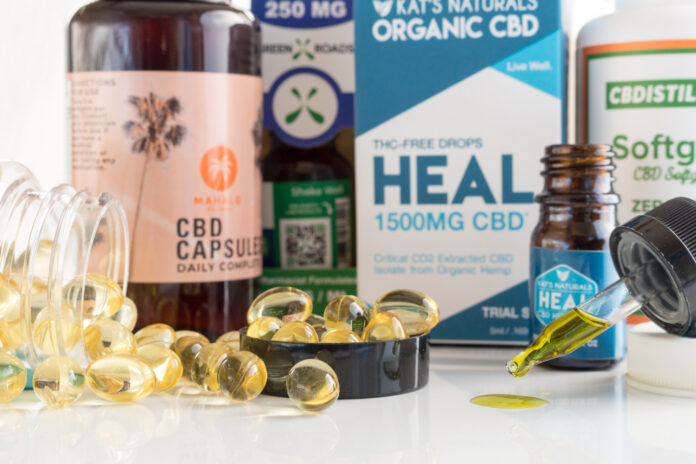Annual cannabidiol (CBD) sales in the United States surpassed $4 billion in 2022, and if the federal government implements centralized regulations for the industry, the nation’s annual sales could reach $11 billion by 2027. With three types of CBD on the market, there are a lot of different niches for retailers to fill. From grocery stores to wellness spas, CBD now lines the shelves at an assortment of retail locations providing a wide range of benefits for nearly every customer demographic.
Consumers can opt for full-spectrum CBD containing all the natural chemical compounds present in hemp plants, like terpenes, flavonoids, and trace amounts of THC. Similarly, broad-spectrum CBD gives people the option to enjoy much of the full-spectrum experience without any THC. For those who want pure CBD, the market also offers products made with CBD isolates. Each type of CBD serves a specific purpose and helps the industry stay competitive across a wide variety of product categories in dispensaries and mainstream stores.
3 Types of CBD
CBD, short for cannabidiol, is a cannabinoid or chemical compound found in the Cannabis sativa plant. The compound is produced and stored in the shimmery trichomes that create the signature sticky residue on the surface of cannabis and hemp flowers.
The production of CBD was federally legalized when the U.S. Congress passed the Agriculture Improvement Act of 2018, often referred to as the 2018 Farm Bill. The bill authorized the production of Cannabis sativa, or hemp, as long as the final product contains less than 0.3 percent THC. Because of the 2018 Farm Bill, the vast majority of CBD products available in the nation are hemp-derived.
To extract CBD from the hemp plant in its raw form, manufacturers typically use carbon dioxide, butane, or ethanol extraction methods. The extraction process pulls the valuable compounds from the plant, but it does not isolate the compounds from one another. Supercritical extraction, a process becoming somewhat of a gold standard in the CBD industry, is a nontoxic method that preserves more of the natural compounds in the cannabis plant. Highly pressurized carbon dioxide behaves as a nonvolatile solvent, but the process is more expensive and slower than other methods.
Producing different types of oil for things like tinctures and CBD vapes requires different extraction methods. Liquid chromatography creates an exact overview detailing the amount of CBD in an extract. Because the cannabis industry lacks comprehensive regulation, voluntary third-party testing on final products is often a mark of a reputable CBD brand.
Full spectrum
Many cannabis enthusiasts interested in engaging the human endocannabinoid system are inclined toward full-spectrum CBD products, which means the other cannabinoids, flavonoids, and terpene compounds produced by the plant are extracted along with the CBD. This form of CBD, along with broad-spectrum products, could be considered impure because it contains additive chemical compounds.
While a full-spectrum CBD oil is not intoxicating, it can contain up to 0.3 percent THC as stipulated by the 2018 Farm Bill. The THC content in full-spectrum CBD is minuscule, but the abundant terpenes allow for the entourage effect valued by customers across the country. Some consumers claim full-spectrum CBD products are superior to isolates and broad-spectrum CBD products.
High-quality full-spectrum CBD products come in many forms from vapes to butter, but full-spectrum oils are particularly popular in the wellness market. CBD oils can be added to foods, beverages, and topical solutions to create their desired effect. The global CBD skincare market alone is expected to expand at a compound annual growth rate of over 30 percent through 2030, and a plethora of new research is being conducted to learn more about the powers of full-spectrum hemp products. As we learn more about the entourage effect and how CBD interacts with serotonin receptors it is likely the popularity of full-spectrum CBD products will continue to grow.
Broad spectrum
Broad-spectrum CBD is very similar to full-spectrum CBD because it preserves terpenes, flavonoids, and cannabinoids during the extraction process. What separates the two types of CBD is the presence of THC in the extract. Broad-spectrum CBD removes the THC compounds from the extract through an additional process.
Broad-spectrum products are designed to provide consumers with the entourage effect they desire without THC intoxication. And while the extraction processes are precise, there is still a chance that trace amounts of THC will be present in the final product. For this reason, broad-spectrum CBD products should be considered nearly THC-free rather than completely void of the compound.
Broad-spectrum CBD products are popular in the wellness market and offer a more approachable appeal to those who are unfamiliar with the larger cannabis industry. The stigma attached to cannabis products has diminished over the years, but the public’s perception of the plant is still evolving. Broad-spectrum CBD products give consumers the opportunity to explore the therapeutic potential of cannabis without worrying about intoxication.
Isolate
CBD isolate is different from the other types of CBD because it does not contain any cannabis compounds aside from CBD. After the initial extraction process, the product undergoes an additional extraction phase called winterization. This distillation process filters out unwanted terpenes, cannabinoids, lipids, and chlorophyll by selectively heating and cooling the substance. The CBD is temporarily turned into vapor and then condensed as a pure extract.
CBD isolate is valuable because consumers know they are taking in pure CBD without any other cannabinoids, but it will not provide consumers with the entourage effect. CBD isolate is sometimes turned into a powder that consumers can mix directly into their beverages or food, but it is also frequently made into oils.
CBDA vs CBD
CBDA, or cannabidiolic acid, is a compound found in fresh cannabis plants. CBDA is referred to as an acid precursor to CBD and the conversion happens only when cannabis is heated or decarboxylated. Another important cannabinoid precursor is CBGA, which is often referred to as the mother of all cannabinoids.
Decarboxylation can happen gradually, as flower cures, or almost immediately when cannabis is vaporized, smoked, or cooked. That’s why it’s important to store a CBDa or CBD product at room temperature. Both compounds are nonpsychoactive cannabinoids, which means they do not produce the same cerebral effects as THC.
While there is significantly more research conducted on the therapeutic benefits of CBD, scientists are beginning to discover positive health effects from CBDA consumption as well. CBDA does not bind to the endocannabinoid receptors in the human body in the same way as CBD, but studies have shown CBDA may have anti-nausea, anti-inflammation, and pain-relieving qualities. In fact, CBDA has greater bioavailability than CBD, which means the human body absorbs the compound better.
Other nonpsychoactive cannabinoids like cannabichromenic acid (CBCA) are showing promise in medicine. In one study published in the journal of antibiotics, researchers determined the compound “demonstrated faster and more potent bactericidal activity than vancomycin, the currently recommended antibiotic for the treatment of MRSA infections.” Methicillin-resistant Staphylococcus aureus (MRSA) or staph is resistant to many antibiotics and causes serious infections that can lead to sepsis and death.
Both CBD and CBDA are found in full and broad-spectrum CBD products like oils, topicals, and tinctures, but some consumers choose to juice fresh hemp leaves to get their CBDA. Many enthusiasts and professionals suggest consuming CBD and CBDA simultaneously to encourage a stronger combined effect on the body.
Growing evidence suggests the cannabinoids naturally present in cannabis are more effective when they are not isolated. This is known as the entourage effect. Harnessing the power of the entourage effect in cannabis products can help brands break into the craft cannabis and premium product markets.


